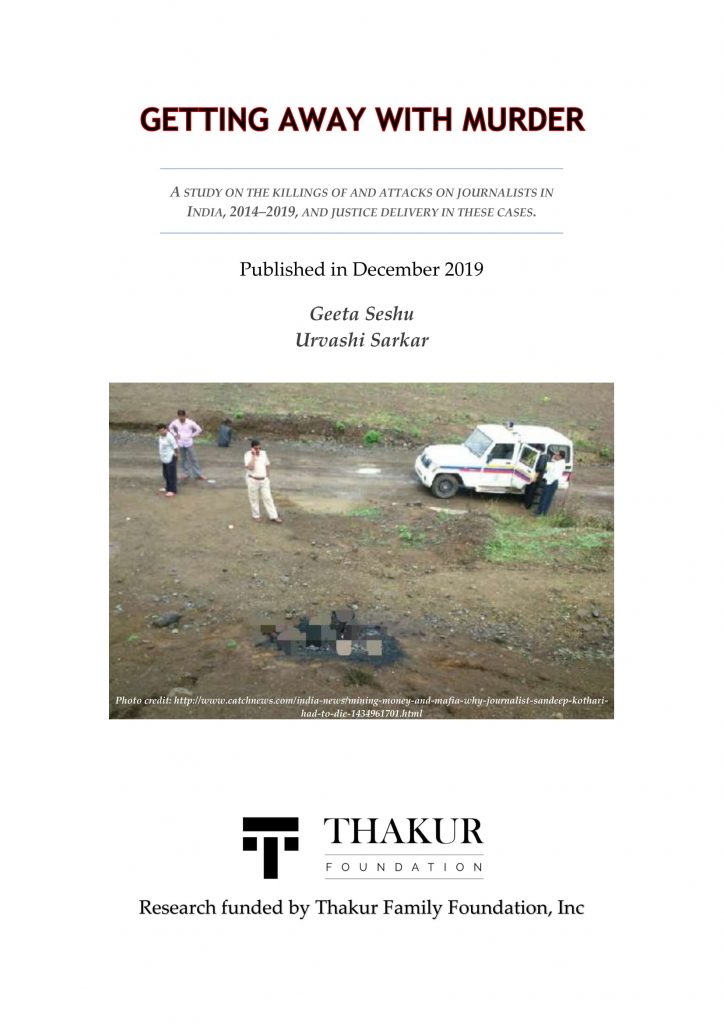A study on the killings of and attacks on journalists in India, 2014–2019, and justice delivery in these cases
GETTING AWAY WITH MURDER is a study on the killings of and attacks on journalists in India, 2014–2019, and justice delivery in these cases.
Since 2014, there have been more than 200 serious attacks on journalists in India. There has not been a single conviction in attacks on journalists in India, targeted for their investigative work.
In the latest spate of attacks in the wake of protests over the passage of the Citizenship Amendment Bill, journalists in Assam, Uttar Pradesh, Delhi and Karnataka, have been detained, assaulted, their camera equipment snatched and even banished into a neighbouring state!
Journalists on the frontlines of information gathering in India have been killed or attacked, some to within an inch of their lives. Further, they have been rendered defenceless by a systemic failure to deliver justice.
This study on the deaths and attacks on journalists in India between 2014-19 documented at least 40 killings of journalists, 21 of which were directly linked to their professional work.The study documented 198 serious instances of attacks on journalists between 2014-19 and at least 36 in 2019 (including the recent attacks on the media in Assam and in Delhi in the wake of the protests over the Citizenship Amendment Act) till date.
Even as we go to the press comes news of the death of news channel journalist Jobanpreet Singh in a shooting near Moga, Punjab. His colleague Gurchet Singh, working for a vernacular daily, was injured in the shooting and police are still investigating the motive for the killing.
With this, the number of journalists killed in 2019 goes to seven but preliminary investigations indicate that only one, the killing of K Satyanarayana in Andhra Pradesh, was linked to the journalist’s professional work.
In another instance, senior environmental and wildlife journalist Naresh Mitra succumbed to injuries after a possible assault on December 9, 2019, eighteen days after he was found bleeding and unconscious near his office in Guwahati, Assam. Further verification is difficult at this point, given the curfew and clampdown on online communication due to the agitation in Assam over the passage of the Citizenship Amendment Bill.
Indeed, the turmoil all over the country over the passage of this act has had its fallout on the media. In an astounding act, Karnataka police detained seven journalists from Kerala in Mangaluru for ostensibly holding an accreditation from the neighbouring Kerala, which Karnataka police considered invalid! After holding them for over seven hours, the journalists were transported in a bus and dropped to Thalapaddy across the border in Kerala.
In another shocking incident, Omar Rashid, the Uttar Pradesh correspondent of The Hindu was detained by police for several hours and subjected to communal abuse. His credentials as a journalist were questioned, as were his origins as a Kashmiri journalist. He was let off and police dismissed it off as a ‘mistake’.
As this study shows, there’s little expectation of accountability or even redressal of these injustices, given the pathetic record of justice delivery of the last six years.
As the courageous Asha Ranjan says, speaking of her struggle to secure justice for the killing of her husband Rajdeo Ranjan in 2016: “The death of my husband is a matter that should concern all journalists. We keep saying that the media is the fourth pillar of democracy. This struggle is not only about the death of one journalist.”
Rajdeo Ranjan was killed after he wrote critical reports about former RJD MP Mohammad Shahabuddin, currently lodged in Siwan jail. The Central Bureau of Investigation (CBI) was conducting investigations in the case but in October this year, without any warning and even without her knowledge, the case was transferred to the special crime branch under the Bihar government. Three days ago, after her notice, CBI officials attended a hearing but did not depose, leaving her in doubt about the future of the investigation and her struggle for justice.
Justice Delivery
The pattern of obfuscation and delay was replicated in almost all the cases tracked by this study. The status of justice delivery for the killing of 20 journalists and 63 attacks on journalists targeted for their investigative work between 2014-18.
Convictions in the killing of journalists are near-zero. Of the over 30 killing of journalists since 2010, there were only three convictions. The cases were J Dey, killed in 2011; Rajesh Mishra, killed in 2012 and Tarun Acharya, killed in 2014. In a fourth case of journalist Ram Chandra Chhattrapati, killed in 2002, it took 17 years for justice to be delivered in the life imprisonment order for Dera Sacha Sauda chief Gurmeet Ram Rahim.
Since 2014, there has not been a single conviction in attacks on journalists in India, targeted for their investigative work.
Apart from prominent editors and senior journalists like Gauri Lankesh and Shujaat Bukhari and J Dey, killed in state capitals, a majority of the journalists killed belong to small towns and villages, working with regional media as correspondents or stringers. They are primary information-gatherers on corruption, and unlawful activities of business people, powerful politicians, police and security forces.
Highlights
• There were 40 killings of journalists between 2014-19. Of these, 21 have been confirmed as being related to their journalism.
• Of the over 30 killing of journalists since 2010, there were only three convictions. The cases were J Dey, killed in 2011; Rajesh Mishra, killed in 2012 and Tarun Acharya, killed in 2014.
• In a fourth case of journalist Ram Chandra Chhattrapati, killed in 2002, it took 17 years for justice to be delivered in the life imprisonment order for Dera Sacha Sauda chief Gurmeet Ram Rahim.
• The study documented 198 serious attacks on journalists in the period between 2014-19, including 36 in 2019 alone.
• Journalists have been fired upon, blinded by pellet guns, forced to drink liquor laced with urine or urinated upon, kicked, beaten and chased. They have had petrol bombs thrown at their homes and the fuel pipes of their bikes cut.
• Journalists covering conflict or news events were specifically targeted by irate mobs, supporters of religious sects, political parties, student groups, lawyers, police and security forces.
• Attacks on women journalists in the field were found to have increased. The targeted attacks on women journalists covering the Sabarimala temple entry were sustained and vicious. A total of 19 individual attacks of women journalists are listed in this report.
• Perpetrators of the killings and attacks included government agencies, security forces, political party members, religious sects, student groups, criminal gangs and local mafias.
The objective of this study, commissioned by the Thakur Family Foundation, was to document cases of deaths and attacks on journalists from 2014-18, determine the status of justice in these cases as well as make recommendations on how best to tackle the increasing attacks on journalists and secure justice for them as well as how to safeguard the work they do.
Please download the report here.



0 Comments:
Post a Comment
Subscribe to Post Comments [Atom]
<< Home